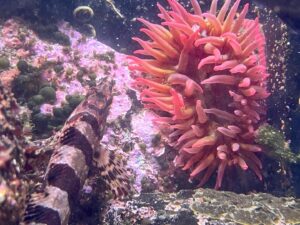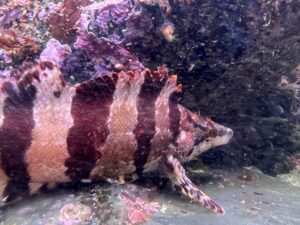
Aquarium, Featured
Aquarium, Featured
Aquarium, Featured
Painted Greenling Oxylebius pictus
Grayish or white with bold dark red stripes the painted greenling darts from one shadowy rock crevice to another. It’s searching for small shrimps or worms for its dinner and does so with ease thanks to its adapted head shape, its snout is long and narrow, perfect for hard-to-reach places. The painted greenling, though small is a striking fish in appearance, not only does it sport five to seven bold stripes vertically down its sides, but also has three dark marks radiating from around its glowing eyes and two sets of bushy outgrowths (cirri), one just above the eyes with another set just behind them. Some, especially juveniles, have been found seeking shelter within the stinging tentacles of different anemone species such as painted and fish-eating anemones Urticina piscivora, Urticina grebelnyi which don’t appear to harm the greenlings. During the breeding season in spring and summer months, the males go through a wardrobe change, their gray or white stripes stripes exchanged for olive green and black and can become quite territorial. Males guard up to ten egg masses, each from different females, and have even been reported to defend them from passing divers. Growing to only about 8 inches from snout to tail the painted greenling can live for approximately 9 years.


Painted greenlings prefer rocky intertidal areas but have been found at over 700ft deep. They range all the way from northern Mexico up the Pacific coast to the Gulf of Alaska.
Our second painted greenling and newest addition to the aquarium was collected near Magic Island in Sitka Alaska, by our own Matt Wilson, Sitka Sound Science Center’s Aquarist and volunteer diver Bri Gabel. Matt and Bri dive regularly off of Sitka’s expansive coastlines, but mostly for observation and study. Collecting specimens for the aquarium requires both a permit from the Alaska Department of Fish and Game as well as a commitment to care for the animal through the remainder of its life. Great care and consideration for each creature’s living conditions is taken into account before any actual collection takes place.


